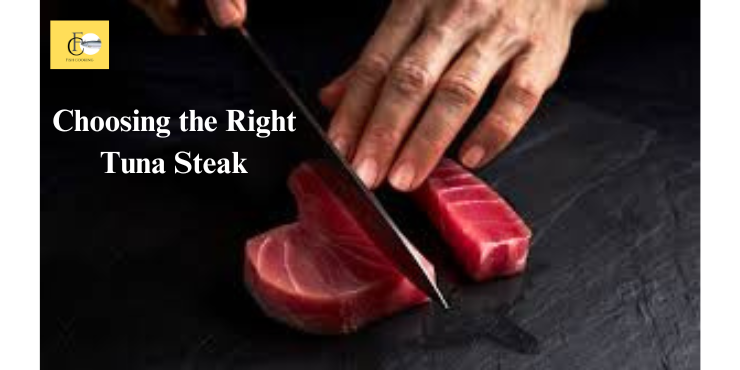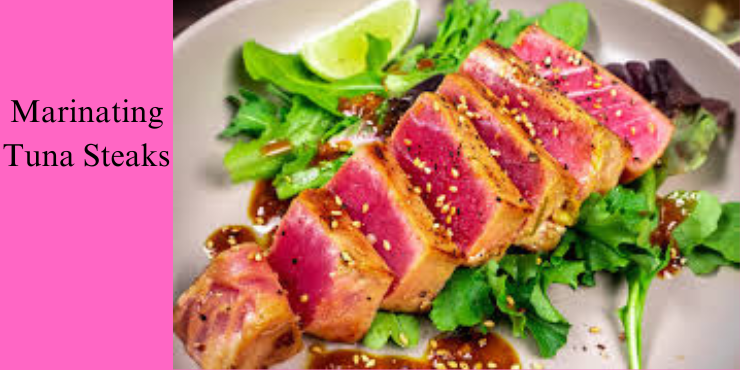Table of Contents
Cooking tuna steaks can be a delightful culinary experience, offering a rich, meaty texture and flavor that’s both satisfying and nutritious. Whether you’re a seasoned chef or a home cook looking to expand your seafood repertoire, learning how to cook tuna steaks properly will ensure you enjoy this delicacy to the fullest.
Choosing the Right Tuna Steak

Before you start cooking, selecting the right tuna steak is crucial. You can choose between fresh and frozen tuna steaks. Fresh tuna steaks often have a brighter color and a more delicate texture, but high-quality frozen tuna can be just as good, especially if flash-frozen immediately after being caught.
Fresh vs. Frozen Tuna Steaks

Fresh tuna steaks are typically found in the seafood section of your grocery store or at a fish market. They should smell fresh and ocean-like, not fishy. Frozen tuna steaks, on the other hand, can be a convenient option, especially if you’re not planning to cook them right away. Just ensure they are fully thawed before cooking for the best results.
Types of Tuna: Yellowfin, Bluefin, and Albacore
Yellowfin (Ahi), Bluefin, and Albacore are the most common types of tuna used for steaks. Yellowfin is often preferred for its mild flavor and firm texture. Bluefin, though more expensive, offers a rich, buttery flavor. Albacore is milder and often less expensive, making it a good choice for budget-conscious cooks.
Sustainable Sourcing Tips
When buying tuna, look for sustainable options. Overfishing has impacted many tuna species, so choosing sustainably sourced tuna helps protect ocean ecosystems. Look for certifications from organizations like the Marine Stewardship Council (MSC).
Preparing Tuna Steaks for Cooking
Proper preparation is key to delicious tuna steaks. Whether you start with fresh or frozen tuna, how you prep them will influence the final flavor and texture.
Thawing Frozen Tuna Steaks
Thaw frozen tuna steaks in the refrigerator for 24 hours. For a quicker method, place them in a sealed plastic bag and submerge in cold water, changing the water every 30 minutes until thawed.
Marinating Tuna Steaks

Marinating adds flavor and moisture to your tuna steaks. A simple marinade can be made with olive oil, soy sauce, lemon juice, garlic, and herbs.
Simple Marinade Recipes
- Soy-Lemon Marinade: Combine soy sauce, lemon juice, minced garlic, and olive oil.
- Herb and Garlic Marinade: Mix olive oil, minced garlic, chopped fresh herbs (like rosemary and thyme), and a splash of white wine.
Seasoning Tuna Steaks
If you prefer not to marinate, a good seasoning will do wonders. Keep it simple with salt, pepper, and a touch of olive oil. For extra flavor, consider adding paprika, cayenne pepper, or sesame seeds.
Basic Seasoning Ideas
- Classic Salt and Pepper: Simple yet effective.
- Mediterranean Blend: Salt, pepper, garlic powder, and dried oregano.
- Asian Influence: Salt, pepper, and a sprinkle of sesame seeds.
Cooking Methods for Tuna Steaks
There are several methods to cook tuna steaks, each offering a different texture and flavor profile. Here’s how to grill, pan-sear, bake, and broil tuna steaks.
Grilling Tuna Steaks
Grilling gives tuna steaks a delicious smoky flavor.
Preparing the Grill
Ensure your grill is clean and preheated to high heat. Oil the grates to prevent sticking.
Grilling Techniques
- Place tuna steaks on the grill and cook for about 1-2 minutes per side for rare, 3-4 minutes for medium-rare.
- Avoid overcooking; tuna is best served rare to medium-rare to keep it tender and moist.
Pan-Seared Tuna Steaks
Pan-searing is a quick and easy method that results in a beautifully crusted exterior.
Choosing the Right Pan
Use a heavy-bottomed skillet, preferably cast iron, for even heat distribution.
Step-by-Step Pan-Searing Process
- Heat the pan over high heat until very hot.
- Add a small amount of oil with a high smoke point, like canola or grapeseed oil.
- Sear tuna steaks for about 1-2 minutes per side for rare, 3-4 minutes for medium-rare.
Baking Tuna Steaks
Baking is a gentle method that preserves the tuna’s moisture.
Preheating the Oven
Preheat your oven to 400°F (200°C).
Baking Instructions
- Place seasoned tuna steaks on a baking sheet lined with parchment paper.
- Bake for 10-12 minutes, depending on thickness, until they reach your desired doneness.
Broiling Tuna Steaks
Broiling offers a quick cooking method with a caramelized exterior.
Setting Up the Broiler
Preheat your broiler and position the rack about 6 inches from the heat source.
Broiling Tips
- Place tuna steaks on a broiler pan or baking sheet.
- Broil for about 4-5 minutes per side, checking frequently to avoid overcooking.
Cooking Times and Temperature Guidelines
Cooking tuna steaks to the right temperature ensures they are safe to eat while maintaining their best texture and flavor.
Ideal Internal Temperatures for Tuna Steaks
- Rare: 115-120°F (46-49°C)
- Medium-Rare: 125-130°F (52-54°C)
- Medium: 135-140°F (57-60°C)
Cooking Time Chart for Different Thicknesses
- 1-inch thick: 1-2 minutes per side (rare), 3-4 minutes per side (medium-rare)
- 1.5-inch thick: 2-3 minutes per side (rare), 4-5 minutes per side (medium-rare)
- 2-inch thick: 3-4 minutes per side (rare), 5-6 minutes per side (medium-rare)
Serving Tuna Steaks
How you serve your tuna steaks can elevate your dining experience.
Suggested Side Dishes
- Grilled Vegetables: Asparagus, bell peppers, and zucchini.
- Salads: A light, fresh salad with mixed greens and a citrus vinaigrette.
- Rice or Quinoa: Simple and versatile grain options.
Plating and Presentation Tips
- Slice tuna steaks against the grain for a tender bite.
- Drizzle with a complementary sauce, like a lemon butter or soy glaze.
- Garnish with fresh herbs for a pop of color and flavor.
Common Mistakes to Avoid
Overcooking Tuna Steaks
Overcooked tuna becomes dry and tough. Always aim for rare to medium-rare for the best texture.
Undersalting
Tuna can handle a good amount of seasoning. Don’t be afraid to use enough salt to enhance its natural flavors.
Using the Wrong Cooking Oil
High smoke point oils like canola or grapeseed are best for searing. Avoid using olive oil at high temperatures as it can burn and impart a bitter taste.
Health Benefits of Tuna Steaks
Nutritional Profile
Tuna is a lean source of protein, low in fat and calories. It’s an excellent choice for a healthy diet.
Omega-3 Fatty Acids Benefits
Rich in omega-3 fatty acids, tuna supports heart health, reduces inflammation, and can improve brain function.
Protein Content
With about 25 grams of protein per 3-ounce serving, tuna steaks are a great way to meet your daily protein needs, especially for those who are active or looking to build muscle.
Conclusion
Cooking tuna steaks may seem intimidating at first, but with the right preparation and cooking techniques, it’s a straightforward process that yields delicious results. Whether you grill, sear, bake, or broil, you can enjoy restaurant-quality tuna steaks at home.
FAQs
How do I know when tuna steak is done? Tuna steaks are done when they reach an internal temperature of 115-120°F for rare or 125-130°F for medium-rare. They should still be pink in the center.
Can you eat tuna steak raw? Yes, tuna steaks can be eaten raw if they are sushi-grade, meaning they are safe for raw consumption. Always ensure you buy from a reputable source.
How should tuna steak be stored? Store tuna steaks in the refrigerator for up to two days. For longer storage, freeze them, but ensure they are properly sealed to prevent freezer burn.
What are the best seasonings for tuna steak? Simple seasonings like salt, pepper, garlic powder, and herbs work well. You can also try Asian-inspired flavors like soy sauce, sesame oil, and ginger.
Is tuna steak healthy? Yes, tuna steak is very healthy. It is high in protein, low in fat, and rich in essential nutrients like omega-3 fatty acids, which are beneficial for heart and brain health.

